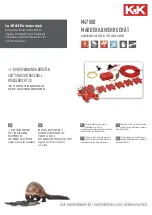
32 Control Modules—Network Control Module 200 Series
Port 1 Type
For the NCM200, Port 1 is not a submodule; it is the port to the integrated
N2 circuit. Accept the default value of N2.
!
CAUTION: The NCM200 Definition window allows other
options. However, Port 1 refers to the integrated N2
connection. You must enter N2 or the port will not
function. No internal check is made to ensure that N2
was selected.
Port 2 Type
(L2, S2, JC85, or blank) For the NCM200, Port 2 indicates the
communications submodule slot.
•
Enter L2 to connect C210 and C260 controllers to the NCM over their
local bus.
•
If you enter S2 as the Port 2 type, a Baud Rate field appears, whose
valid range is 4800 or 9600.
•
If you enter JC85 as the Port 2 type, a Baud Rate field appears, whose
range is 1200 to 19,200 in the standard baud increments. The best
performance is achieved at 9600 baud.
For devices that connect to the RS-232 submodule or integral modem
submodule, designate this port type as Blank. For the Operator Terminal
program set, designate this port type as Blank.
To define the device that connects into the RS-232 submodule, it is
necessary to call that particular device’s Definition window (e.g., a
directly connected OWS’s Definition window).
Devices that plug into the RS-232 port are also defined at their own
Definition window, instead of on the NCM Definition window.
NT Baud Rate
(300, 600, 900, 1200, 2400, 4800, 9600) Default is 9600.
The Network Terminal transmits at the default 9600 baud rate.
NT Port options are provided to accommodate NT Emulator connections.
The Emulator connects to the NT port via the NT jack, and can transmit at
different baud rates, depending on the incoming external modem.
This also sets the Operator Terminal baud rate if an OT is connected to
Port 2 or Port 4.
For more information, refer to Using the NT Emulator in the Network
Terminal User’s Manual (FAN 633).
















































